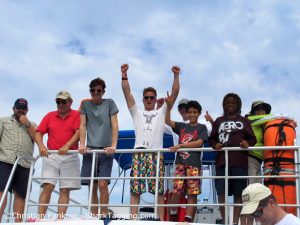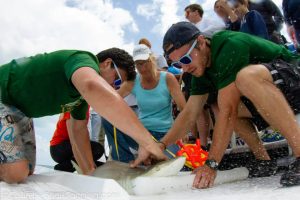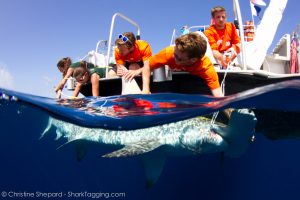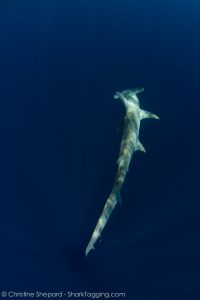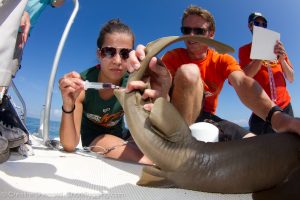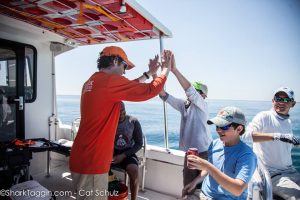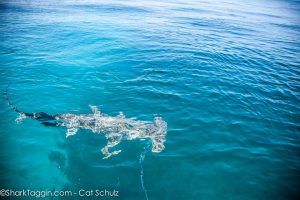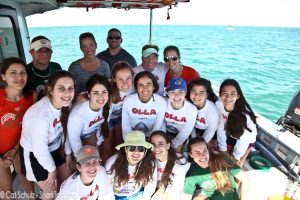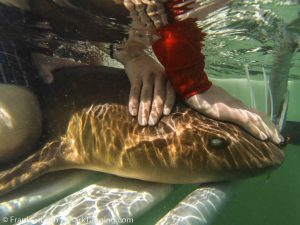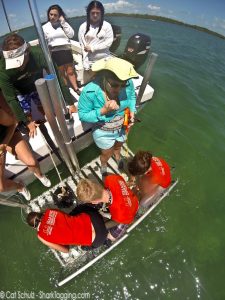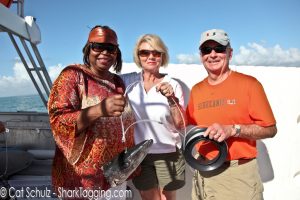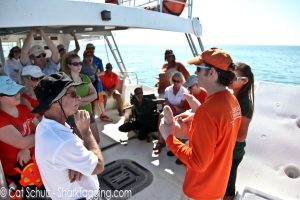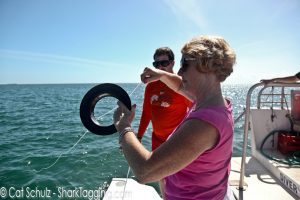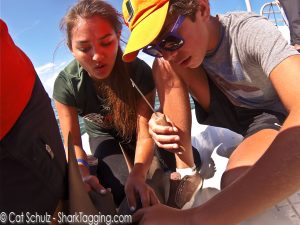Shark Tagging with Big Brothers- Big Sisters
By Laurel Zaima, RJD Intern
It was a dreary and blustery morning in Key Biscayne for our Saturday shark-tagging trip. The heavy clouds were rolling in and the wind started to pick up. We all hoped that this weather would soon pass because wind and rain is not ideal weather for shark tagging. Sharks attend to move off shore with high winds, which might make our trip less successful than we would have hoped. Nevertheless, we were still going out on the water and everyone kept high spirits! After we loaded the boat with our equipment and the guests were all settled in, we were on our way! The guest group, Big Brothers-Big Sisters, that came out on the boat with us were excited to become citizen scientists by helping us collect data for our shark research. Some of our guests have never seen a shark up close before, so our RJD team was equally as excited to share this experience with them.
Led by our RJD trip leader, Pat Goebel, and Captain Eric, our enthusiastic RJD team for Saturday’s trip was Catherine, Christian, Kyra, Sam, and myself. It was only a quick boat run out to our site off of Key Biscayne; however, by that time the clouds had already started to lift and we could see the sun peaking through.
Once we arrived at our site, we deployed our first set of 10 drumlines with the help of our guests, and we let them soak for 1 hour. It seemed that with the change in weather, our luck changed as well! We caught a male nurse shark (1.91 meters total length) on the first drumline of the first set! We were able to collect data swiftly and accurately, and the shark swam off in great condition. The second drumline we pulled up had a lot of tension on the line and we predicted that this shark was going to be a big one! All of a sudden… the line snapped! That means that the shark on the other end of the line was strong enough to break 900-pound strength monofilament fishing line. Although we were a little disappointed we lost the shark, we were that much more determined to catch him again. On the fourth drumline, we caught a large (2.46 meters total length) female lemon shark, and from the body’s girth, we predicted that this female is pregnant.
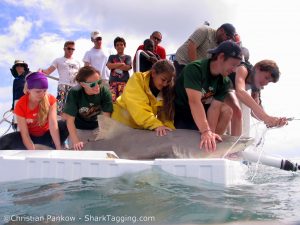
The RJD team (left to right: Sam, Kyra, Laurel, Pat, Catherine) secures and prepares the female lemon shark for a safe release back into the ocean.
On the very next drumline, we caught another lemon shark; however, this male lemon shark was slightly smaller in size (1.78 meters total length). To conclude the first set, we caught a female black tip shark (1.70 meters total length) on the tenth drumline.
This was a great start to the day, and our success only continued! On the first drumline of the second set, we caught a beautiful male Tiger shark (2.42 meters total length). Tiger sharks are one of my favorite species, so I was especially excited to catch such a gorgeous fish. When we finally saw the tiger shark break the surface, everyone was amazed by the intricate markings of this species of shark. Tiger sharks can be most easily identified by their distinct tiger print pattern on their body. Once we pulled the shark on the platform, I secured the head of my first tiger shark! I have collect samples and data from tiger sharks before, but encountering this shark so up close was a completely different experience. While at the head of the shark, I was captivated by the tiger shark’s big glossy eyes. I think I fell in love! After a quick work up, the tiger was released back into the ocean in great condition. We didn’t catch any more sharks in the second set, but we still had one more set of ten drumlines to catch some more sharks!
The first drumline of the third set we caught another nurse shark (female; 2.06 meters total length). To conclude our data collection, we caught we caught a blacknose shark! Blacknose sharks are a smaller species, and this female had a total length of 1.29 meters. Our team doesn’t catch blacknose sharks very frequently, so today was our lucky day!
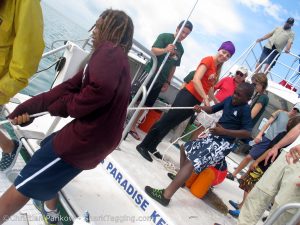
The guests from Big Brothers-Big Sisters worked together to pull up a drumline in hopes that there is a shark on the other end!
Just as everyone thought the excitement was over and it was time to head back to shore, I took one wrong step and slipped right off the platform and into the water! Fortunately, Captain Eric was the first one to see me fall into the water and immediately put the boat in neutral so I didn’t get left behind. The brisk water gave me a little shock, but I was absolutely fine. I’ll just have to be careful where I put my clumsy feet next time!
Although the morning began a little gloomy, the weather cleared up very nicely and it ended up being a beautiful and sharky day! The guests of the Big Brother-Big Sister program not only had an opportunity to see a shark for the first time, but they also were able to touch a shark and help us collect data! The RJD team was very fortunate to go out with such an enthusiastic group, and we look forward to go shark tagging with Big Brothers- Big Sisters again!

